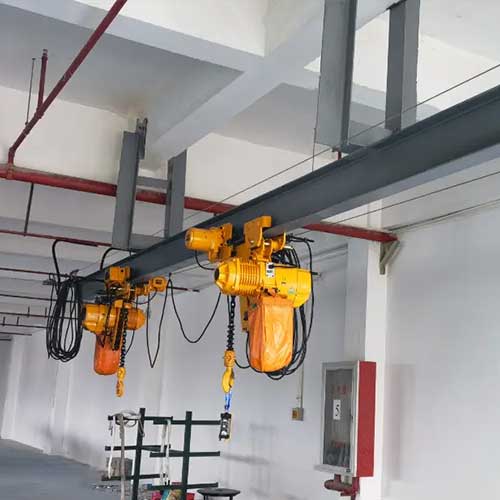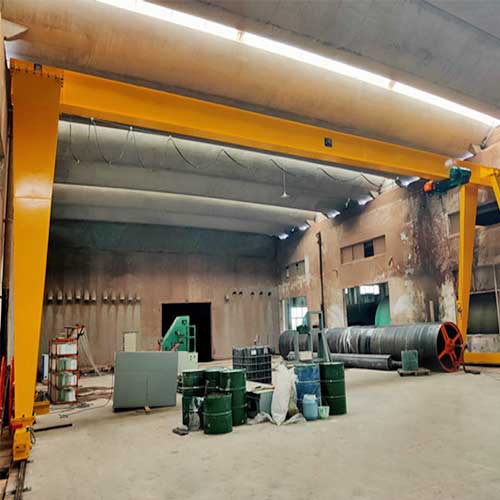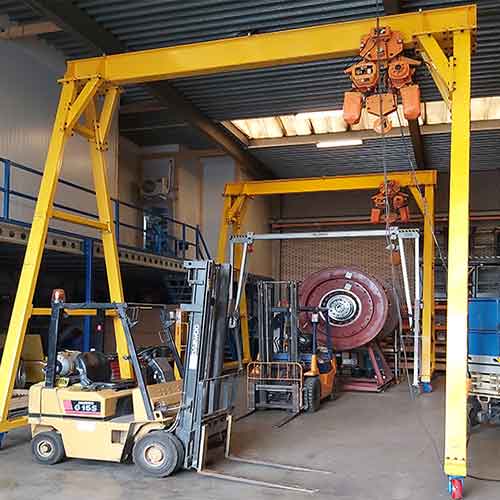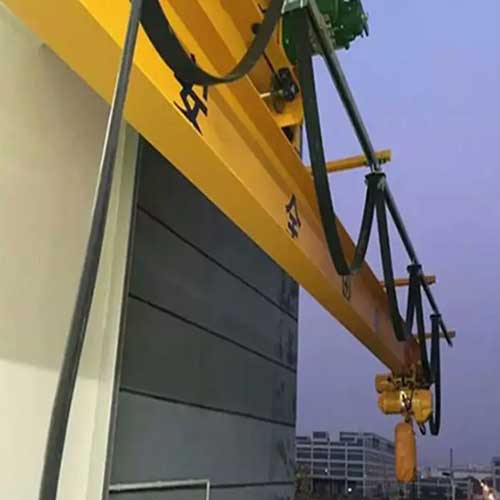I Beam Cranes & I Beam Crane Hoists, Custom I Beam Crane Hoist
I beam cranes and I beam hoists for sale. Custom i beam cranes and hoists for your needs, good price i beam hoist, chain hoist, rope hoist, overhead crane & gantry cranes.
Category: Beam Crane
Your Trusted Overhead Travelling Crane Manufacturer & Supplier
I Beam Cranes & I Beam Crane Hoists, Custom I Beam Crane Hoist
I beam cranes and I beam hoists for sale. Custom i beam cranes and hoists for your needs, good price i beam hoist, chain hoist, rope hoist, overhead crane & gantry cranes.
I Beam Cranes in Modern Industry
I Beam cranes stand as stalwarts in the realm of industrial lifting equipment, playing a pivotal role in shaping the landscape of material handling. These powerful devices have transformed the way industries lift, move, and position heavy loads, contributing significantly to operational efficiency and productivity.
The evolution of I Beam cranes dates back to the early advancements in lifting mechanisms. Their roots can be traced to the Industrial Revolution, where the need to efficiently move heavy materials propelled the development of more robust lifting solutions. Over time, these cranes have undergone significant enhancements, leveraging technological innovations to meet the growing demands of diverse industries.
At their core, I Beam cranes operate on a simple yet efficient principle: the use of a horizontal I shaped beam (girder) as a structural element for lifting and moving heavy objects. These cranes are equipped with a variety of components, including trolleys, hoists, end trucks, and control systems, all working in unison to facilitate smooth and precise lifting operations.
Significance in Material Handling
The significance of I Beam cranes in industrial settings cannot be overstated. Their ability to handle substantial loads with precision and reliability makes them indispensable across various sectors. From manufacturing plants lifting heavy machinery to warehouses loading and unloading cargo, I Beam cranes are the backbone of material handling operations, ensuring efficiency and safety.
In today's fast paced industrial landscape, I Beam cranes continue to be at the forefront of material handling solutions. Their versatility, robustness, and adaptability make them indispensable assets in optimizing lifting operations, contributing directly to enhanced productivity and streamlined workflows.
As industries evolve and embrace technological advancements, I Beam cranes remain a steadfast choice for meeting the ever growing demands of lifting heavy loads. Their historical evolution, coupled with their relevance in modern material handling, underscores their pivotal role in driving efficiency across diverse industrial sectors.
Types of I Beam Cranes
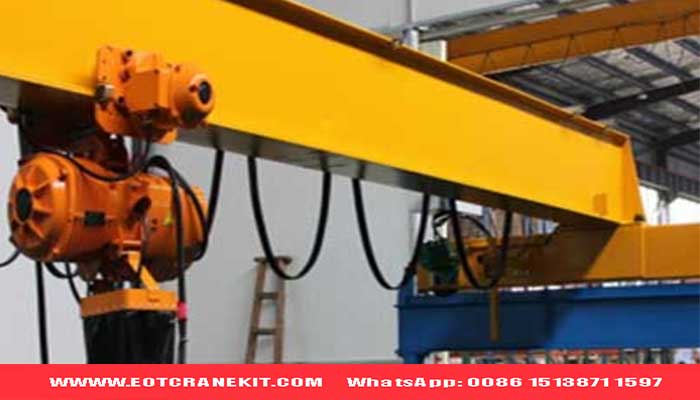
Top Running Overhead I Beam Crane
Description:
Runs on tracks installed on top of the runway beams.
Offers substantial load capacities and spans, suitable for heavy duty lifting.
Provides precise and smooth movement along the tracks.
Features:
High load capacities, suitable for heavy materials and machinery.
Precise and stable movement for demanding industrial applications.
Customizable configurations to meet specific lifting needs.
Benefits:
Ideal for heavy manufacturing plants and steel mills.
Offers durability, stability, and adaptability in various industrial settings.
Ensures efficient and precise material handling for heavy loads.
Typical Applications:
Heavy manufacturing and assembly operations.
Foundries and metalworking facilities.
Construction sites requiring heavy material handling.
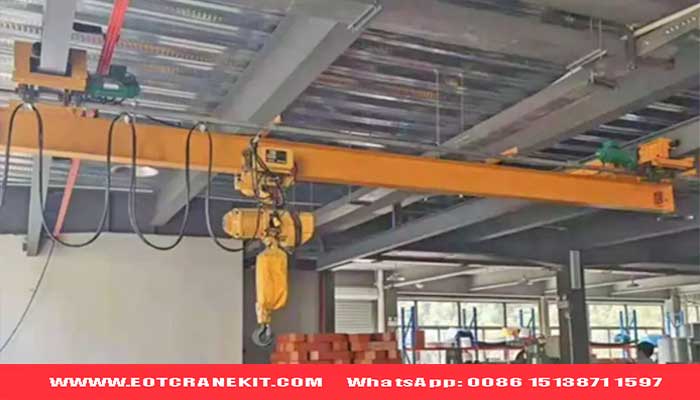
Underhung Overhead I Beam Crane
Description:
Suspended from the bottom flange of the runway beams.
Designed for areas with limited headroom or space constraints.
Provides lateral movement below the beam.
Features:
Saves vertical space and enables lateral movement for light to moderate loads.
Precise maneuverability in workshops and areas with restricted headroom.
Customizable options for specific lifting requirements.
Benefits:
Optimal for workshops and warehouses with restricted headroom.
Space saving and adaptable to confined areas for efficient material handling.
Provides flexibility in lateral movement for various lifting tasks.
Typical Applications:
Workshops with low headroom or restricted vertical space.
Warehouses and storage facilities with limited clearance.
Assembly lines and maintenance areas requiring lateral movement.
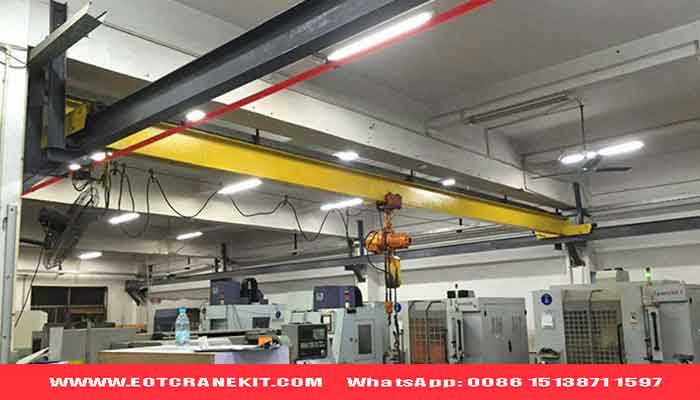
Single Girder Overhead I Beam Crane
Description:
Features a single girder design for lifting operations.
Suitable for moderate lifting capacities and spans.
Provides a cost effective solution for various applications.
Features:
Cost effective and efficient for light to moderate loads.
Offers compact design and ease of installation.
Provides precise and smooth lifting operations.
Benefits:
Ideal for small manufacturing units and assembly lines.
Economical solution for material handling with moderate capacities.
Compact design for facilities with space constraints.
Typical Applications:
Small manufacturing units and workshops.
Assembly lines and fabrication facilities.
Maintenance and repair workshops.

Double Girder Overhead I Beam Crane
Description:
Utilizes two parallel girders for increased stability.
Offers higher load capacities and larger spans.
Provides enhanced lifting capabilities for heavy loads.
Features:
High load bearing capacities suitable for heavy duty lifting.
Robust construction for stability and durability.
Greater hook height and precision in material handling.
Benefits:
Ideal for heavy duty industrial applications.
Suitable for foundries, steel mills, and heavy machinery lifting.
Provides enhanced safety and reliability for heavy loads.
Typical Applications:
Foundries and steel mills.
Heavy machinery and component handling.
Manufacturing facilities requiring heavy duty lifting.
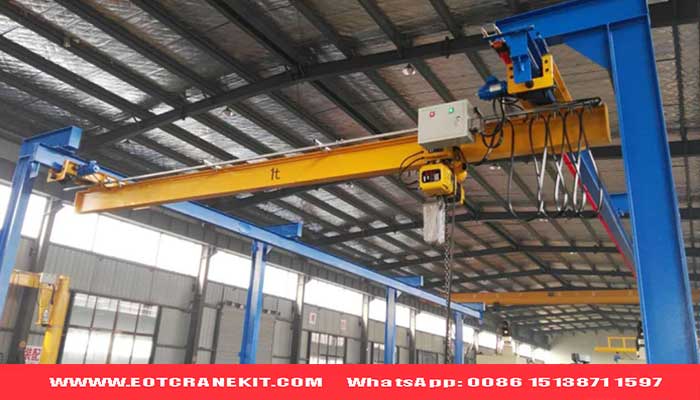
Freestanding Overhead I Beam Crane
Description:
Self supporting structure without the need for building support.
Offers mobility and flexibility in installation.
Allows for overhead lifting without attaching to the building structure.
Features:
Mobility and flexibility for installation in open areas.
Self contained structure for easy relocation.
Adjustable and customizable for various lifting needs.
Benefits:
Suitable for outdoor construction sites and temporary installations.
Offers mobility and adaptability without relying on building support.
Ideal for open spaces requiring overhead lifting solutions.
Typical Applications:
Outdoor construction and infrastructure development.
Temporary installations and project specific lifting needs.
Loading docks and open area material handling.

Description:
Supported on ground level rails or wheels.
Offers lateral movement for material handling.
Suitable for both indoor and outdoor applications.
Features:
Mobility and flexibility for varied lifting needs.
Stability and adaptability to different surfaces.
Customizable options for specific requirements.
Benefits:
Versatile and suitable for outdoor applications.
Provides mobility and flexibility for diverse material handling tasks.
Ideal for shipping yards, construction sites, and outdoor manufacturing.
Typical Applications:
Construction sites and infrastructure development.
Shipping yards and outdoor material handling.
Manufacturing facilities with outdoor storage needs.

Description:
Comprises a horizontal boom pivoting around a vertical axis.
Offers localized lifting and movement.
Suitable for precise and specific lifting tasks.
Features:
Provides localized lifting for specific workstations.
Offers precise and controlled movement for targeted lifting.
Customizable configurations to meet specific operational needs.
Benefits:
Ideal for confined spaces or specific workstations.
Provides precise and controlled lifting for specialized tasks.
Increases efficiency and ergonomics in targeted lifting operations.
Typical Applications:
Machine shops and manufacturing workstations.
Loading docks and confined spaces requiring precision lifting.
Assembly lines with specific material handling needs.

Description:
Operates on a single rail or track system.
Designed for linear movement and material handling.
Offers simplicity and cost effectiveness.
Features:
Economical and space saving solution.
Suitable for linear material handling tasks.
Customizable configurations for specific applications.
Benefits:
Cost effective and space saving solution.
Ideal for assembly lines and linear material handling needs.
Provides simplicity and efficiency in linear lifting operations.
Typical Applications:
Assembly lines and production processes requiring linear movement.
Paint booths and continuous production lines.
Material handling in confined linear spaces.

Workstation I Beam Crane
Description:
Small scale overhead crane for specific workstations.
Designed for localized and repetitive lifting tasks.
Offers ergonomics and efficiency.
Features:
Increases efficiency and ergonomics for repetitive tasks.
Provides localized lifting for specific workstations.
Customizable options for various workstation needs.
Benefits:
Increases efficiency and reduces worker fatigue.
Provides localized lifting for specific workstation tasks.
Enhances ergonomics and safety for repetitive lifting operations.
Typical Applications:
Workstations in manufacturing and assembly lines.
Maintenance areas and specific workstations.
Any repetitive lifting tasks requiring ergonomics.
Features and Benefits of I Beam Cranes
Features:
Load Capacities: Varied load bearing capabilities depending on the crane type, ranging from light to heavy duty lifting.
Lifting Heights: Adjustable lifting heights designed to meet specific vertical reach requirements.
Span Capabilities: Diverse spans cover short to extensive distances within a workspace.
Benefits:
Provides flexibility to handle loads of different sizes and weights.
Offers vertical reach adaptability for various lifting tasks.
Accommodates different workspace layouts and requirements.
Precision Controls, Safety Features, and Automation Integration
Features:
Precision Controls: Advanced control systems for accurate and controlled movements during lifting operations.
Safety Features: Integrated safety measures like overload protection, emergency braking, and limit switches.
Automation Integration: Capability to integrate with automated systems and IoT for enhanced operational efficiency.
Benefits:
Ensures precise and controlled movements, enhancing safety and accuracy during lifting.
Mitigates risks by incorporating safety mechanisms, reducing accidents and potential damage.
Integration with automation streamlines operations, increasing efficiency and productivity.
Space Optimization, Adaptability, and Customization Options
Features:
Space Optimization: Compact designs suitable for facilities with limited space or height restrictions.
Adaptability: Versatility to adapt to varying environmental and operational conditions.
Customization: Options for customization to fit specific operational requirements.
Benefits:
Allows efficient use of limited space within industrial settings.
Provides adaptability to diverse operational environments and conditions.
Customization ensures that the crane system aligns precisely with specific operational needs.
Industrial Applications of I Beam Cranes
- Manufacturing Sector Handling Heavy Machinery: Lifting, relocating, and assembling heavy machinery and equipment within manufacturing plants. Raw Material Handling: Transporting and positioning raw materials for production processes. Component Handling: Moving manufactured components across the production line.
- Construction Industry Lifting Construction Materials: Hoisting heavy construction materials like steel beams, concrete blocks, and equipment to desired heights. Assembly and Installation: Facilitating the assembly and installation of structural elements and components.
- Warehousing and Logistics Efficient Loading and Unloading: Loading and unloading cargo efficiently, optimizing storage and logistics processes. Material Movement: Handling various goods and materials within warehouses for storage and distribution.
- Other Specialized Sectors Automotive Industry: Handling vehicle parts, chassis, and assembly line components. Aerospace and Aviation: Transporting aircraft parts or engine components. Shipbuilding: Lifting and moving ship components during the assembly process.
Factors Influencing I Beam Crane Selection
Load Capacities, Span, and Headroom
Considerations:
Load Capacities: Determining the maximum weight the crane will lift and transport.
Span: Assessing the distance the crane needs to cover within the workspace.
Headroom: Evaluating the available vertical space for lifting operations.
Operational Environments and Space Constraints
Considerations:
Operational Environments: Analyzing the environment, such as temperature, humidity, and potential hazards, to ensure the crane's suitability.
Space Constraints: Assessing available space to accommodate the crane and its movement without hindrance.
Structural Support and Installation Requirements
Considerations:
Structural Support: Evaluating the building structure's capacity to support the crane's weight and the load it will carry.
Installation Requirements: Determining installation feasibility and any modifications needed for the crane's setup.
Maintenance and Safety Practices
Recommended Maintenance Schedules and Inspection Protocols
Maintenance Schedules:
Regular Inspections: Conducting routine checks for wear, tear, and potential malfunctions.
Scheduled Servicing: Following manufacturer recommended service intervals for components and mechanisms.
Inspection Protocols:
Visual Inspections: Regular visual checks for damages, misalignments, or unusual sounds during operation.
Functional Tests: Periodic testing of controls, emergency features, and safety mechanisms.
Compliance with Safety Standards, Operator Training, and Risk Mitigation
Safety Standards:
Regulatory Compliance: Adhering to industry safety standards and regulations for crane operation.
Operator Training: Ensuring operators are adequately trained, certified, and aware of safety protocols.
Risk Mitigation:
Risk Assessment: Conducting regular risk assessments to identify potential hazards and implementing preventive measures.
Emergency Protocols: Establishing emergency procedures and training staff for prompt responses in critical situations.
Common Safety Concerns and Best Practices for Safe Operation
Safety Concerns:
Overloading: Avoiding exceeding load capacities to prevent accidents and equipment damage.
Collision Avoidance: Implementing measures to prevent collisions with objects or other cranes.
Fall Hazards: Mitigating risks associated with working at heights during crane operation.
Best Practices:
Clear Communication: Ensuring clear communication among crane operators and ground personnel.
Preventive Maintenance: Emphasizing the importance of regular maintenance for optimal crane performance and safety.
Continuous Training: Providing ongoing training to operators to keep them updated with safety practices and operational protocols.
Customization and integration of I Beam cranes enable businesses to meet exact lifting demands, improve operational efficiency, and capitalize on technological advancements in the industrial sector. These adaptations contribute significantly to enhanced performance, safety, and productivity in various industrial settings.
I Beam cranes stand as indispensable assets in various industries, offering versatility, efficiency, and robust lifting capabilities. These cranes play a pivotal role in streamlining material handling operations across sectors, ensuring precise and safe lifting of loads while optimizing operational efficiency.
Investing in tailored I Beam crane solutions is paramount for industries seeking to enhance their material handling capabilities. Customized configurations align precisely with specific industrial lifting demands, optimizing performance, increasing safety, and ensuring adaptability to evolving operational needs.
The realm of material handling continues to evolve, driven by technological advancements and industry demands. Emphasizing the importance of continuous innovation, adaptation, and integration of the latest technologies into I Beam cranes ensures that industries stay at the forefront of efficient and safe lifting operations.
I Beam Crane Hoists
Unveiling the Versatility and Efficiency of I Beam Crane Hoists
In the bustling world of industrial operations, the role of efficient and versatile lifting equipment cannot be overstated. Among these crucial tools, I Beam Crane Hoists stand tall as indispensable assets, facilitating the seamless movement and precise lifting of heavy loads within industrial settings.
I Beam Crane Hoists serve as vital components in the realm of material handling, ensuring the safe and efficient lifting of substantial loads in various industrial sectors. Understanding the nuances of these hoists, including their diverse types, distinct features, benefits, and applications, becomes imperative for businesses seeking optimal lifting solutions.
Industries across the spectrum, from manufacturing facilities to construction sites and warehouses, rely heavily on the functionality and reliability of I Beam Crane Hoists. These hoists epitomize efficiency, offering versatility in lifting heavy loads while ensuring precision and safety in material handling processes.
As we delve deeper into the world of I Beam Crane Hoists, exploring their types, features, applications, and addressing user concerns, it becomes evident that comprehending these critical aspects is pivotal for users and potential purchasers seeking to optimize their lifting operations.
Exploring Types of I Beam Crane Hoists
I Beam Crane Hoists come in an array of variants, each designed with distinct mechanisms, load capacities, and specialized functionalities. Understanding these diverse types is crucial to pinpointing the perfect match for specific industrial lifting needs.
Electric Winch Hoists represent a category tailored for vertical lifting along the I beam track. They utilize an electric winch mechanism, enabling efficient lifting and lowering operations. These hoists offer simplicity in vertical lifting without lateral movement, making them ideal for straightforward lifting tasks in varied industrial applications.
Wire Rope Hoists are renowned for their robustness and ability to handle heavier loads with ease. Utilizing durable wire ropes wound around a drum connected to the hoist motor, these variants excel in high load lifting scenarios. Their sturdy construction and higher load capacities make them indispensable in heavy duty industrial lifting operations.
Chain Hoists, characterized by their chain based lifting mechanisms, offer flexibility and ease of use. These hoists provide moderate load capacities and portability, making them suitable for diverse lifting operations in workshops, warehouses, and other industrial environments. Their adaptability to various lifting scenarios and ease of maneuvering make them a popular choice for many applications.
Beyond these primary categories, other specialized variants, such as pneumatic hoists, come into play for specific industrial niches. These variants leverage air pressure to facilitate lifting, catering to environments where electrical systems may not be suitable.

Features:
Vertical Lifting: Primarily designed for vertical lifting along the I beam track.
Electric Winch Mechanism: Facilitates efficient lifting and lowering operations.
Simplified Operation: Offers simplicity in straightforward lifting tasks.
Benefits:
Precise Vertical Movement: Enables precise and controlled vertical lifting without lateral movement.
Efficiency: Streamlines vertical lifting operations, enhancing overall efficiency.
Applications:
Construction Sites: Ideal for lifting materials to height in construction projects.
Warehouses: Suitable for vertical lifting tasks within warehouse environments.
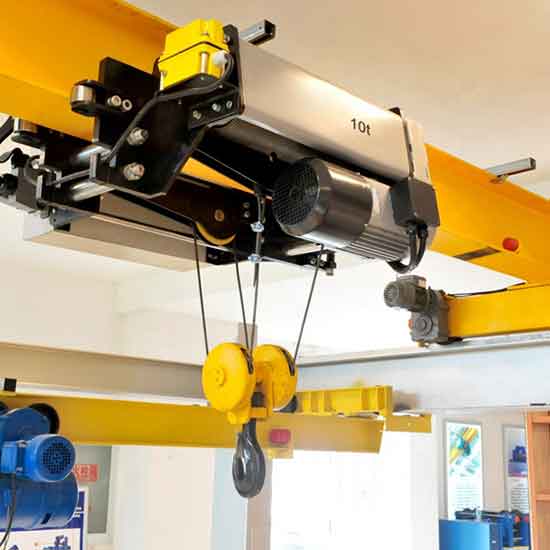
Features:
Robust Wire Rope Mechanism: Utilizes durable wire ropes wound around a drum for lifting.
High Load Capacities: Capable of handling heavier loads efficiently.
Sturdy Construction: Designed for durability and endurance in heavy duty lifting operations.
Benefits:
Heavy Load Handling: Excels in scenarios demanding high load lifting capacities.
Durability: Resilient construction ensures longevity in demanding industrial environments.
Applications:
Manufacturing Facilities: Ideal for lifting heavy machinery and components.
Shipping Yards: Suitable for loading and unloading heavy cargo containers.

Features:
Chain Based Mechanism: Uses chains for lifting and lowering operations.
Flexibility and Portability: Offers adaptability and ease of maneuvering.
Moderate Load Capacities: Suitable for various lifting tasks.
Benefits:
Versatility: Adaptable to different lifting scenarios within workshops and warehouses.
Ease of Use: Simple and portable, enabling quick and flexible lifting operations.
Applications:
Workshops: Suitable for handling varied loads in workshop settings.
Warehousing: Ideal for lifting and moving moderate loads in warehouse operations.
Typical Industrial Applications of I Beam Crane Hoists
I Beam Crane Hoists are veritable workhorses in numerous industrial sectors, showcasing their versatility and indispensable role in elevating operational efficiency. Let's delve into the practical applications across various industries where these hoists are instrumental in material handling processes.
Manufacturing Industry
Within manufacturing facilities, the utilization of I Beam Crane Hoists is ubiquitous. These hoists efficiently handle heavy machinery, large components, and raw materials. Their robustness and ability to manage substantial loads streamline production processes, expediting material handling operations.
Example Scenario: A wire rope hoist adeptly positions and transports massive industrial components along the manufacturing assembly line, ensuring precision and swift movement without compromising safety protocols.
Construction Sector
Construction sites rely extensively on I Beam Crane Hoists to lift construction materials, equipment, and tools to desired elevations. The versatility of electric winch hoists aids in vertical lifting tasks, accelerating construction projects and ensuring efficient material movement.
Example Scenario: An electric winch hoist seamlessly hoists construction materials to upper floors of a skyscraper under construction, facilitating efficient and safe material transport at great heights.
Warehousing and Logistics
In warehousing and logistics operations, I Beam Crane Hoists are pivotal for the smooth handling of heavy cargo containers, pallets, and goods. Chain hoists' adaptability and maneuverability play a pivotal role in various lifting tasks within these environments.
Example Scenario: A chain hoist efficiently maneuvers and positions pallets of inventory in a warehouse, optimizing storage space and expediting logistics operations.
These real world scenarios underscore the instrumental role of I Beam Crane Hoists in diverse industrial settings. From manufacturing facilities requiring precision handling to logistics centers optimizing space, these hoists are invaluable assets that enhance productivity and streamline operations across industries.
Top Concerns and FAQs of I Beam Crane Hoist Users
Addressing Concerns: FAQs and Top Considerations for I Beam Crane Hoists
Users and potential purchasers often have queries and concerns regarding the operation, maintenance, safety standards, and compatibility of I Beam Crane Hoists. Let's delve into addressing these common concerns to offer comprehensive guidance.
Maintenance Queries
Q: What is the recommended maintenance schedule for I Beam Crane Hoists?
A: Regular maintenance is crucial for optimal performance. Periodic inspections, lubrication of moving parts, and addressing wear and tear should be conducted as per the manufacturer's guidelines.
Q: How can I ensure the longevity of my I Beam Crane Hoist?
A: Adhering to proper maintenance schedules, timely repairs, and using the hoist within recommended load limits are key to ensuring longevity.
Safety Standards and Load Limits
Q: What safety measures should I consider when using I Beam Crane Hoists?
A: Ensuring operator training, following safety protocols, regular inspections, and utilizing safety features such as limit switches and overload protection are essential for safe usage.
Q: Are there specific load limitations for I Beam Crane Hoists?
A: Each hoist type has distinct load capacities. Always adhere to these limitations specified by the manufacturer to prevent accidents or overloading.
Compatibility and Adaptability
Q: How do I determine the compatibility of an I Beam Crane Hoist with different beam sizes?
A: Consulting the hoist's specifications and user manual to ensure compatibility with various beam sizes is crucial. Some hoists offer adjustable features to accommodate different beams.
Q: Can I use the same hoist for different industrial settings?
A: Depending on the hoist's specifications and features, some hoists are versatile and adaptable to different industrial settings. However, always ensure compatibility and adherence to safety standards.
Addressing these frequently asked questions and concerns regarding maintenance, safety, load limitations, and compatibility assists users and potential purchasers in making informed decisions. Understanding and adhering to these considerations are pivotal for optimizing the efficiency, safety, and longevity of I Beam Crane Hoists in industrial settings.
Conclusion: Elevating Operations with I Beam Crane Hoists
I Beam Crane Hoists stand as stalwarts in the realm of industrial lifting equipment, providing unparalleled efficiency, safety, and versatility. Their paramount role in optimizing lifting operations across various industries cannot be overstated.
The versatility and efficiency of I Beam Crane Hoists redefine lifting operations, offering precise and reliable material handling solutions. From manufacturing facilities requiring heavy duty lifting to logistics centers aiming for optimized workflows, these hoists streamline operations, augmenting productivity and efficiency.
In conclusion, understanding the diverse types, features, applications, and addressing common user concerns surrounding I Beam Crane Hoists is pivotal. Informed decision making, supported by comprehensive knowledge and adherence to safety protocols, ensures optimized performance and longevity of these essential lifting assets.
The adaptability, safety features, and load bearing capacities of I Beam Crane Hoists exemplify their potential to elevate industrial operations. Leveraging the power of these hoists not only ensures efficient material handling but also underscores a commitment to safety and enhanced productivity.
Embracing the versatility, efficiency, and safety that I Beam Crane Hoists offer encourages industries to propel their operational capabilities to new heights. Their role in revolutionizing lifting operations remains indispensable, catering to the ever evolving needs of diverse industrial sectors.
Main Projects
Related Products

Supplied three grab bucket crane kits to Indonesia, enhancing garbage handling efficiency with high load capacity and reliable performance.
Free consultation to Confirm Parameters & Specifications and Get
Latest Crane Price & Crane Rate.
- Types of overhead cranes : _______?
- Optional: Overhead travelling crane, goliath gantry crane,Slewing jib crane, Single girder or double girder crane,small portable crane or kbk crane, etc.
- Capacity of overhead crane: _______?
- Optional: 0.25ton, 0.5 ton, 1 ton, 2 ton, 3ton, 5 ton, 10 ton,15ton, 20ton, 25 ton, 30ton,35ton, up to 550ton, etc.
- Crane span & lifting height : _______?
- Crane travelling length : _____?
- Control of overhead crane:_______?
- Optional: pendant/ remote/cabin control
- Voltage supply of overhead crane:_____?
- Eg,: 380V50/60HZ,3Phase or others,etc.
- Application/usage of crane:_______?
- Eg,: Steel mill, ,injection mold, cement,stone, concrete,granite, general manufacturing, etc.
Just leave a message via the contact form and our hoist and crane engineer will contact you with in 24working hours.
Get In Touch
